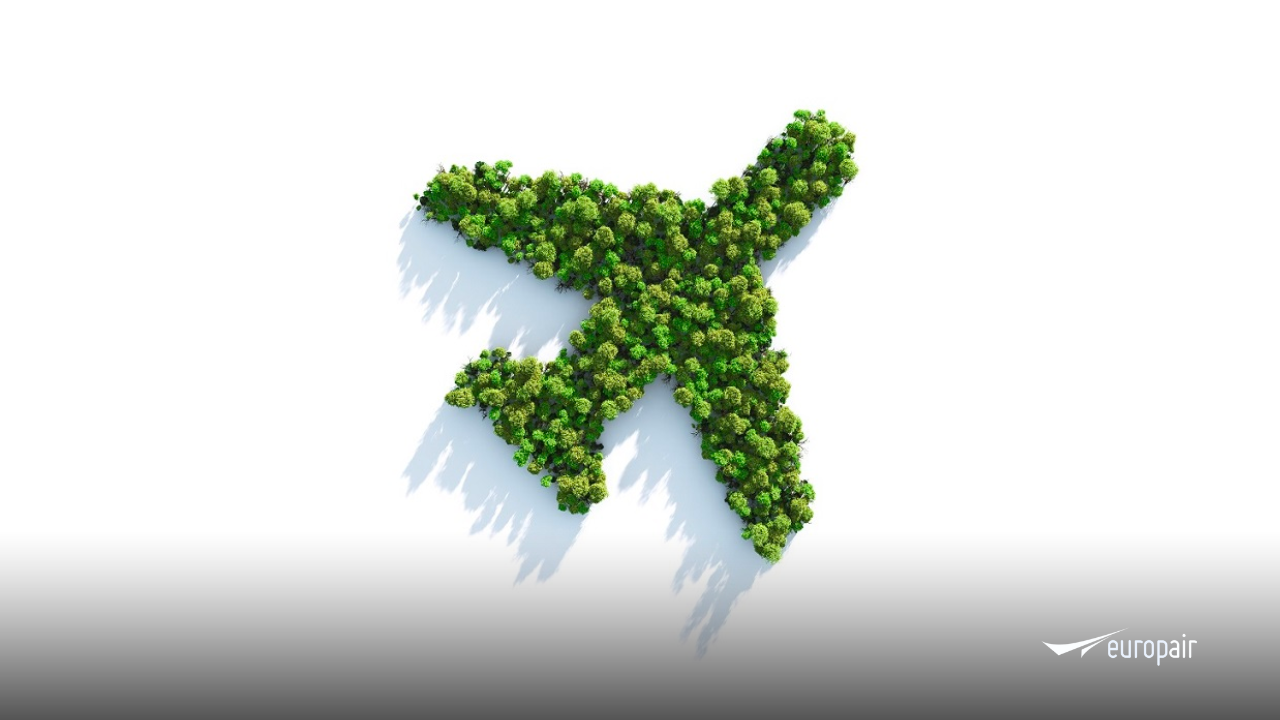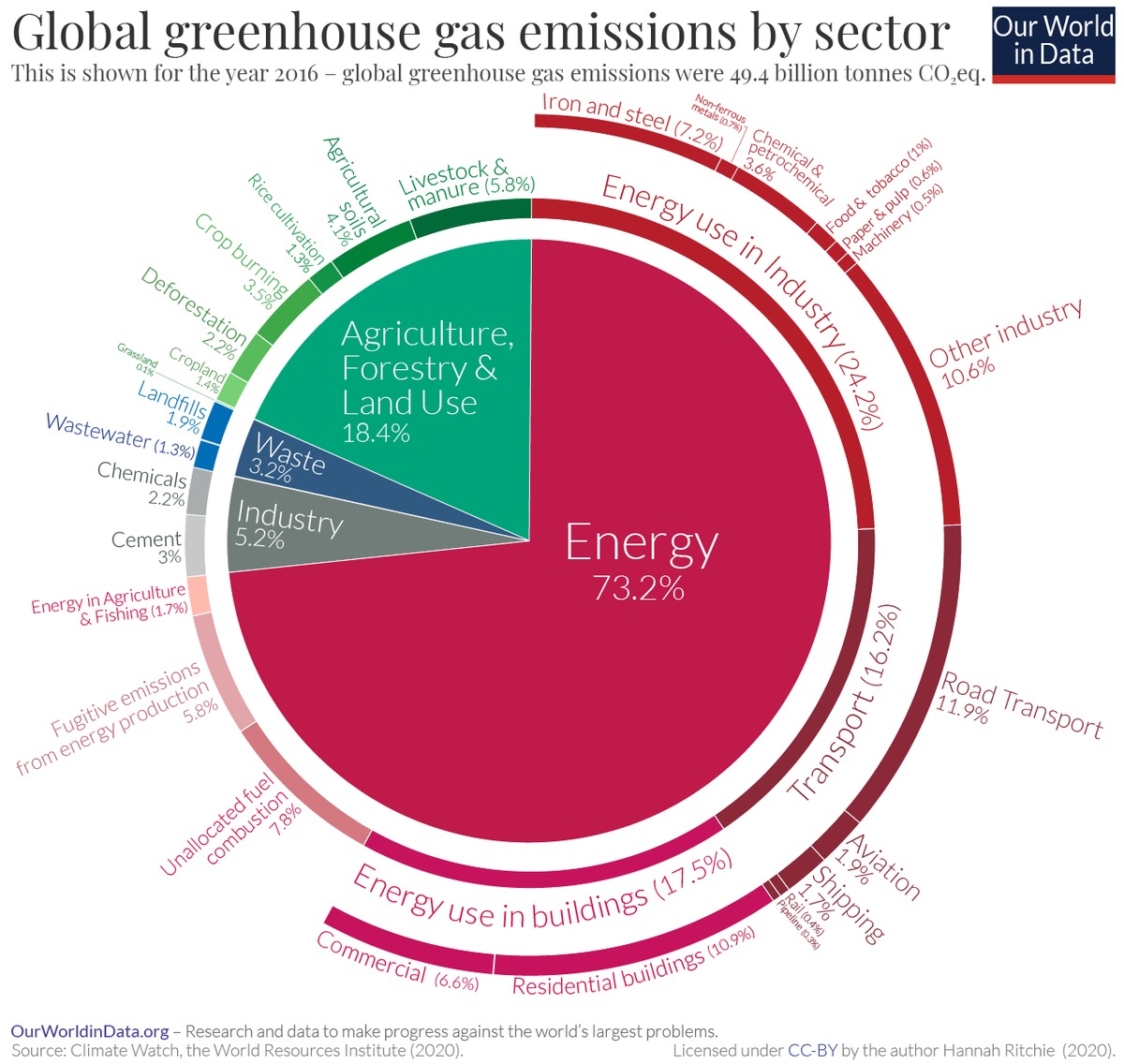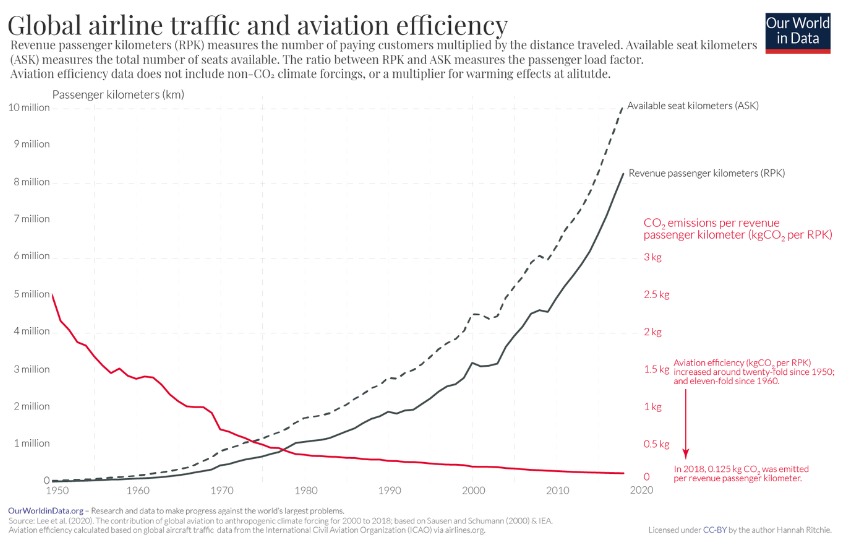
The skies, with us
The Truth About Aviation's Environmental Impact

In recent years, the aviation sector has been subject to criticism for its environmental impact. It has been pointed out that aviation is responsible for a significant portion of greenhouse gas emissions (GHGs) and contributes to climate change. However, to what extent is this true? What percentage does the aviation sector represent in Europe? What has been the evolution over the years? What impact does it have on society?
It is important to note that aviation is a relatively innocuous sector compared to others that generate more emissions and are not as hostilely portrayed in the media. According to data from Our World in Data, the aviation sector accounts for only 1.9% of global GHG emissions. This places it far behind other sectors, such as agriculture, which accounts for 18.4%. If we translate the following data from the image into a ranking, aviation ranks 15th out of 29, excluding percentages and industries within the 10.6% of GHGs from "Other industry," so the position of the aviation sector could be in the second half of the total.
To illustrate this difference, we can use the following image:

In this image, we can see that the aviation sector represents a small fraction of total GHG emissions. Specifically, of the 16.2% (within the 73.2% of energy) that symbolizes transportation as a whole, aviation only represents 1.9% of total emissions, while agriculture represents 18.4% of the total, energy used in buildings 17.5%, industry 24.2%, and other sectors represent 11.9%.
It is also important to note that aviation emissions are not distributed evenly worldwide. According to the "Global Aviation Emissions Report 2022" by the International Air Transport Association (IATA), the percentage of estimated greenhouse gas emissions from aviation by continent in 2022 was as follows:
- Asia: 60.1%
- America: 25.5%
- Europe: 9.9%
- Africa: 2.5%
- Oceania: 2.0%
These data show that Asia is the region that contributes the most to aviation emissions, followed by America. Europe and Oceania represent a much smaller proportion of total emissions. Therefore, it is important to emphasize the idea that aviation in Europe represents a tiny part of global emissions, while everything suggests that it is precisely in Europe where the most aggressive campaign against the industry is taking place, making it a perspective from the media that is neither in line with reality nor fair to the aviation sector. In absolute terms, we can conclude that aviation emissions in Europe are much lower than aviation emissions in Asia or America.
This information is important for understanding the environmental impact of aviation. It is evident that aviation has a significant impact on the environment, but this impact is not uniform worldwide. Therefore, it is important for countries in Asia and America to take measures to reduce aviation emissions, as they are the ones that contribute the most to this problem.
Evolution of Air Traffic and Emissions since 1970
While it is true that air traffic has increased, emissions have not grown at the same rate thanks to improvements in efficiency. Over the past 50 years, aviation has been one of the most important forms of transportation but has also been a source that has contributed to global emissions. Although aviation emissions have increased almost seven times since 1960 and quadrupled since 1970, the growth of air travel has been even faster.
The significant decrease in the rate of emission increase indicates significant advances in aircraft efficiency. The graph illustrates the global growth of air travel since 1950 and aviation efficiency, measured by the amount of CO2 released per Revenue Passenger Kilometer (RPK). In 2018, each RPK released approximately 125 grams of CO2, twenty times less than in 1950 and eleven times less than in 1960.
Among the factors that have contributed to these advances are the following: increased aircraft size, improvements in aircraft technology and design, and a greater number of flights with full passenger occupancy. The Passenger Load Factor (PLF) measures the proportion of seats occupied relative to the total capacity of the aircraft. Between 1950 and 2018, the global occupancy factor increased from 61% to 82%. In short, more aircraft are being used more efficiently to transport more people, which has contributed to the improvement in aviation efficiency.
To illustrate the difference in air occupancy, we can use the following image:

Innovation in Aviation in Europe
In Europe, the aviation sector accounts for 9.9% of total GHG emissions. This means that aviation in Europe is responsible for a smaller proportion of total emissions than in other regions of the world.
Additionally, it is important to note that aviation in Europe is taking steps to reduce its environmental impact. For example, European airlines have invested in new technologies to reduce fuel consumption or have made modifications to air routes to make them more efficient. They have also been working on developing new sustainable aviation fuels (SAF), which have the potential to reduce CO2 emissions by up to 80%. This reduction will be possible if the refineries supplying this type of fuel have the means and infrastructure to make such changes to airport refueling.
It is also worth noting that in 2022, the European Union (EU) approved a series of measures to reduce greenhouse gas emissions, including a specific tax for flights operated by European airlines. This tax, which came into effect on January 1, 2024, will apply to intra-European flights and is based on the number of passengers and the distance traveled.
The intention of this measure is to incentivize European airlines to reduce their CO2 emissions. However, there is also the risk that this tax will create a competitive advantage for non-European airlines, which will not be subject to it and therefore may offer more affordable tickets than those issued by European airlines. Additionally, the tax could increase ticket prices, which could negatively affect tourism.
Economic Impact
According to the International Air Transport Association (IATA), aviation generates more than 65.5 million direct jobs worldwide. These jobs are spread across airlines, airports, aircraft maintenance and repair companies, aircraft manufacturers, and aviation support service providers.
- Airlines: 22.3 million jobs
- Airports: 21.6 million jobs
- Aircraft maintenance and repair: 10.7 million jobs
- Aircraft manufacturers: 8.3 million jobs
- Aviation support service providers: 2.6 million jobs
In turn, the aviation sector also generates around 2.2 million indirect jobs.
It is worth noting that in 2022, the aviation sector generated $2.7 trillion worldwide. This value represents an increase of 4.1% compared to 2021.
Aviation sector revenues are divided into two main categories: passenger transport revenues and cargo transport revenues.
In 2022, passenger transport revenues accounted for 72.4% of total aviation sector revenues, while cargo transport revenues accounted for 27.6%.
Aviation sector revenues are generated through a variety of sources, including airlines, airports, aircraft manufacturers, and aviation support service providers, collectively comprising 4% of Global GDP.
Social Impact
Aviation has had a significant impact on society, driving advances in areas such as global connectivity, international trade, tourism, and humanitarian aid.
Global Connectivity
Aviation has shortened distances between people and cultures, facilitating communication and exchange. This has contributed to globalization, a process that has led to greater interdependence between nations.
International Trade
Aviation has boosted international trade, allowing companies to transport goods and services to markets worldwide. This has contributed to global economic growth and increased well-being for people.
Tourism
Since aviation became democratized, it has made travel easier and more affordable, driving international tourism as one of the industries that contributes most to the global GDP. In the case of Spain, air tourism accounts for 80% of total tourism, representing between 11% and 13% of national GDP.
Humanitarian Aid
If you remember natural disasters such as the 2004 tsunami that devastated the coasts of Indonesia, Sri Lanka, and other nations in the Indian Ocean, the 2010 earthquake in Haiti, or conflicts like the Syrian War in 2011, among others, you will recall how aviation managed to transport humanitarian aid to areas affected by natural disasters or conflicts, saving millions of lives and contributing to alleviating human suffering.
In summary, aviation has had a positive impact on society that is undeniable, contributing to global connectivity, international trade, tourism, and humanitarian aid. Criticizing the aviation sector in a negative and uninformed manner, without having a broader perspective of the numerous advantages it has provided, provides, and will continue to provide, demonstrates a complete lack of understanding of its global impact compared to other more polluting sectors that are not in the media spotlight. It is important to recognize all these premises before issuing a critical opinion about the aviation sector to avoid falling into demagogy.
Our Commitment
Europair, as a European-based air broker, is committed to sustainability and works to join forces with airlines to support their efforts to reduce aviation emissions and make our planet a greener place. Europair's commitment goes beyond being an intermediary in the aviation industry; it seeks to establish strategic alliances with airlines to support and enhance their efforts aimed at mitigating the environmental impact of aviation. Through these collaborations, Europair becomes a catalyst for change, working together with its partners to implement innovative practices and more environmentally friendly technologies in air operations.
Europair recognizes the importance of addressing current environmental challenges and strives to lead the transition to a more sustainable future in the European aviation sector. Would you like to be part of the change?
"Navigate the Sky, Preserving the Earth"
From Europair, we are at your service to introduce you to the world of private aviation and charter flights. We will advise you throughout the process, answer all your questions, and find the best type of aircraft based on your needs.
Are you thinking about booking a private jet or a group charter flight?
Get an instant quote on our private flight page, contact us at web@europair.es, or call +34913952025.



